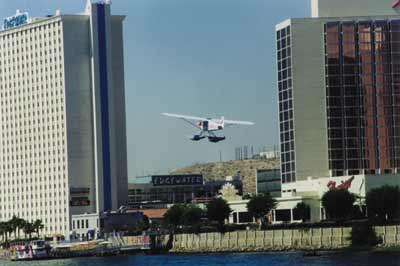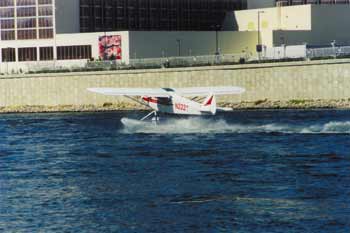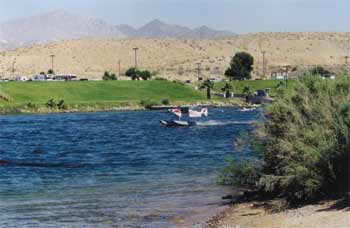|
|

| Get Your Feet Wet |
| Adventures of a New Seaplane Pilot |
| Story by Mark Swint, Photos by Peggy Swint |

|
After nearly 17,000 hours of “dancing aloft” in varieties of aircraft too numerous to count, one would think that as a pilot I would be satisfied with my little niche in the aviation world. It has been a wonderful hobby and career that has taken me to the corners of the Earth and all stops in between. I’ve seen magnificent sunsets and sunrises, comets by night and awe-inspiring thunderstorms by day. By every measure, I should be totally satisfied with my aviation experiences, and I am, to be sure. Why then should I feel this restless spirit urging me to disprove the theory that “you can’t teach an old dog new tricks” and take on a new challenge to my flying ego? Go figure!
In life, some things just don’t seem to mix well. Take, for instance, oil and water, drinking and driving, Sonny and Cher and, one would think, airplanes and water. Yet it is apparent that pilots never were too conventional. After getting away with the thrill of being able to land not just on landing strips, but roads, farmer’s fields, meadows, deserts, and beaches, we pilots said, “we’re still not satisfied!” We want to land everywhere! So, we said, “hey, let’s put boats under our bellies and land on water.” It has long been axiomatic that any airline pilot worth his wings should have a boat, so I guess it was a natural progression from the beginning.
Igor Sikorsky was one of the first to fashion the bellies of his designs in the form of a boat hull and land on water. Others followed suit, including Grumman, who built an industry by designing Mallards, Widgeons, Gooses, and Albatrosses. Boeing and Martin, along with various other manufacturers both here and abroad, followed suit, and soon Pan Am World Airways was plying the world in their Clipperships, while Sunderland did the same for BOAC.
During my brief tenure as a bush pilot in Alaska, I came to realize how useful and practical floatplanes were. One of my favorite things to do whenever I have free time in Anchorage is go down by the shoreline of Lake Hood, right there within the confines of Anchorage International Airport, and watch seaplanes arrive and depart from the busiest seaplane base in the world. Certainly, many parts of Alaska would be absolutely inaccessible were it not for the ubiquitous Super Cub, 185, 206, or Beaver on floats. The rivers and lakes that dot that great land are, very literally, the highways and airstrips for a vast percentage of the state.
While in Alaska, I decided that I too would, one day, get my seaplane rating. However, the years piled up and soon, kids and a career with a major airline got in the way. Seaplane flying faded to the back burner. That all changed, however, when we moved to Southern Nevada and began to enjoy Lake Mead in our boat. Every so often, I would see floatplanes and amphibs sharing the water with us, and I couldn’t help but look with envy as they zoomed in and out of quiet bays and inlets. Then, this spring I was on the lake and saw an odd shape just peaking over a small dune that protected a quiet, little bay. Coming around the corner, my jaw dropped as a beautiful Grumman Albatross came into view. There it was, backed up to the beach with twelve happy folks just sitting there in beach chairs basking in the sun. The owner of the plane was there with cameramen intent on getting some great action photography of the Albatross. I watched with envy as the pilots cranked up the big Pratt and Whitneys and did pass after pass for the cameras. That was the last straw. I was getting my Single Engine Sea rating this year, no matter what!
 One of the dominant flight training schools in the Southwest is Sheble's Aviation, with bases in Henderson, Nevada and Bullhead City, Arizona (just across the river from Lauglin). They offer seaplane ratings in a Piper Super Cub for $695 - check ride included. I called to be scheduled and was informed that the Cub was down for an engine overhaul, float repair, and general aircraft refurbishing. I would need to wait a few months. They were unmoved by my pleas that I couldn’t wait – I guess they found out that I had procrastinated this effort for twenty-three years already and could wait a few more months. So, wait I did, and boy was it worth it! One of the dominant flight training schools in the Southwest is Sheble's Aviation, with bases in Henderson, Nevada and Bullhead City, Arizona (just across the river from Lauglin). They offer seaplane ratings in a Piper Super Cub for $695 - check ride included. I called to be scheduled and was informed that the Cub was down for an engine overhaul, float repair, and general aircraft refurbishing. I would need to wait a few months. They were unmoved by my pleas that I couldn’t wait – I guess they found out that I had procrastinated this effort for twenty-three years already and could wait a few more months. So, wait I did, and boy was it worth it!
The Sheble’s program is a two-day course that starts with, what else, paperwork. After arriving at the Bullhead City airport for my 2:00 PM check-in, my first task was to fill out the application form, and check logbooks, licenses, and medical. I was then given some books on seaplane flying as well as a few loose-leaf articles on the finer points of maneuvering a floatplane. I was sent back to the hotel to read and study for the rest of the evening.
The actual flying began bright and early the next morning with a grand entrance. Joe Sheble III – owner and proprietor of Sheble’s, and known to all as JoJo – met me dockside on the Colorado River after landing the Super Cub right in front of the Riverside Hotel and Casino and taxing to the hotel dock. We talked on the dock for a few minutes, and the pleasantries got right down to business. We did a preflight where he pointed out some of the differences between a floatplane and a land plane. After that it was time to board up and cast off into the river.
JoJo determined that I had read sufficiently the night before, so the first take-off was mine. What a thrill it was to pour the coals to our trusty Lycoming and watch the spray fly off our floats as the plane’s nose first rose from the thrust and then again as it got up on the step.
Much sooner than I had anticipated, it was time to lift off and start flying. Because the Bullhead City airport has a control tower and lies right next to the water on the Arizona side of the river, we coordinated our take off with them. They had us fly right down the river below five hundred feet to our practice area. It was great fun to fly along the upper floors of the various hotels and see people staring back at us from their rooms.
Once airborne, flying a floatplane really isn’t much different than a land plane except for the fact that, during maneuvering, the floats can counteract the stability provided by the rudder because of their large side areas. This is why so many seaplanes have added rudder or vertical stabilizer area. Notwithstanding, I was surprised to see that I really couldn’t “feel” the floats while flying straight and level. I’m not sure what I expected, but the plane seemed just as light and responsive as a wheel equipped version. JoJo explained that the floats added about a hundred pounds, but they created a significant amount of lift, which offsets the difference. In any event, I was satisfied that I wouldn’t have to endure hours of flying a heavy, sluggish plane. Cool!
Though the task at hand was to turn me into a guy that could safely put an airplane into – make that onto – the water, the first maneuvers we did were steep turns and stalls. The turns took quite a bit of rudder input, as any yaw gave the floats more authority than the rudder. The stalls were straightforward and gentle, though here another difference came to light. Seaplane pilots must be very careful when flying near stall speeds because most floats leak to varying degrees, which can cause C.G. problems. If the rear compartments are carrying more water than the front, it is possible to move the C.G. out of limits, which would not be a good thing during a stall.
Duly convinced that I could, in fact, turn a plane around and recover from a stall, we proceeded to the river for landings and takeoffs. Without getting into the nuts and bolts of float flying, I will just say that the single biggest difference I could perceive from land plane flying was that attitude, both for take off and for landing, is much more critical on water. Every degree of pitch places the water at a different spot on the floats. Too far forward and the floats dig in – not good – too far back and the weight and pressure of the plane sits on the back of the floats putting great stress on the floats and fittings. One benefit I can see from this is that learning to fly floats should make a pilot more professional on land as well. I have seen far too many pilots yank a plane off the runway or, conversely, keep it on the ground too long because of poor pitch control. That doesn’t work on floats. To safely fly off water, you must be smooth and professional.
 The training Sheble's gave me lasted almost four hours, and covered a much broader spectrum of items than I had anticipated. I had to learn not only how to land and take off, but also how to do those tasks in rough water and smooth. Believe it or not, glassy smooth water is not as desirable for float operations as is water with a bit of texture on it. Special techniques apply to glassy takeoffs as well as landings. Glassy landings can be treacherous, and special care and procedures must be applied to safely accomplish them. A good example of what can happen on glassy water is found in the first few minutes of the movie “Mother Lode” with Kurt Douglas and Kim Basinger. In one of the most dramatic sequences ever filmed, famed movie pilot Joe Hughes brought a float-equipped Beaver in for landing on a glassy lake. The ensuing crash was not planned and was very real! The script had called for the plane to be sabotaged and sunk by the bad guy later anyway, so the producers worked the crash into the story line. The training Sheble's gave me lasted almost four hours, and covered a much broader spectrum of items than I had anticipated. I had to learn not only how to land and take off, but also how to do those tasks in rough water and smooth. Believe it or not, glassy smooth water is not as desirable for float operations as is water with a bit of texture on it. Special techniques apply to glassy takeoffs as well as landings. Glassy landings can be treacherous, and special care and procedures must be applied to safely accomplish them. A good example of what can happen on glassy water is found in the first few minutes of the movie “Mother Lode” with Kurt Douglas and Kim Basinger. In one of the most dramatic sequences ever filmed, famed movie pilot Joe Hughes brought a float-equipped Beaver in for landing on a glassy lake. The ensuing crash was not planned and was very real! The script had called for the plane to be sabotaged and sunk by the bad guy later anyway, so the producers worked the crash into the story line.
In addition to taking off and landing, float pilots must practice docking, both in lakes, and on rivers where currents must be dealt with. We flew down the river to the Indian casino “Avi” and used their dock for docking practice. I can attest that docking with a current can be challenging. It takes practice and patience to master this maneuver.
After the river work was completed, we flew to Lake Mohave, just north of Laughlin, where JoJo taught me how to take off in a circle. That was great fun and quite impressive. We then landed in a windier part of the lake and shut down the engine. Docking a plane on a lake with winds can also be very challenging if the wind is blowing into shore, because even with the engine shut down, the plane is still going to act like a sailboat and catch a lot of wind. Much of our training was devoted to learning how to “sail” the plane backward, engine shut down, using the flight controls and the natural weathervaning tendency of the plane to achieve an amazing amount of control. I would have to say that probably half or better of the flight training involved for a float rating concerns docking and sailing with engine at low, low idle or even off.
All of the training was great fun and very rewarding. I was surprised by how much was involved, and very pleased with the thoroughness of the training I received. After a short break it was time for the check ride, which was administered by JoJo’s father, Joe Senior. Big Joe was a very pleasant and affable man who basically asked me to demonstrate all the things that JoJo had taught me. It was obvious that both men loved to fly, and had a refreshing enthusiasm for flight instruction that is all too often missing now days. These men are in it for the long haul and it shows, which is probably why Sheble’s is as successful and busy as it is.
Sheble’s seaplane training is done on the Colorado River, which divides Laughlin, Nevada from Bullhead City, Arizona. The airport and Sheble’s offices are located on the Arizona side, while the hotels are in Laughlin on the Nevada side. This can lead to time zone problems, as the time change runs right down the middle of the river, with Mountain time on the Arizona side and Pacific time on the Nevada side. Be sure to verify times when making arrangements to meet your instructor. You can contact Sheble’s at 800-249-6482 or at shebleaviation.com.
If you are interested in adding a float rating to your ticket, you had better call right away. Sheble’s is very busy and Rachel, the scheduler, may not be able to work you in for some time. No matter how long you have to wait though, it is worth it. Learning to fly floats might just be the means you’ve been looking for to put the fun and excitement back into your flying.
|
Click here to return to the beginning of this article.  |
|